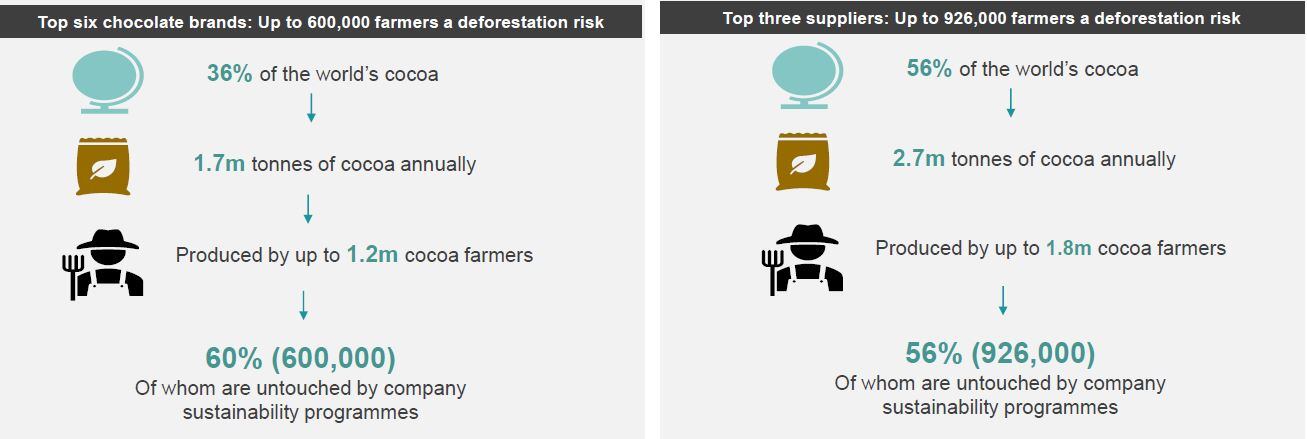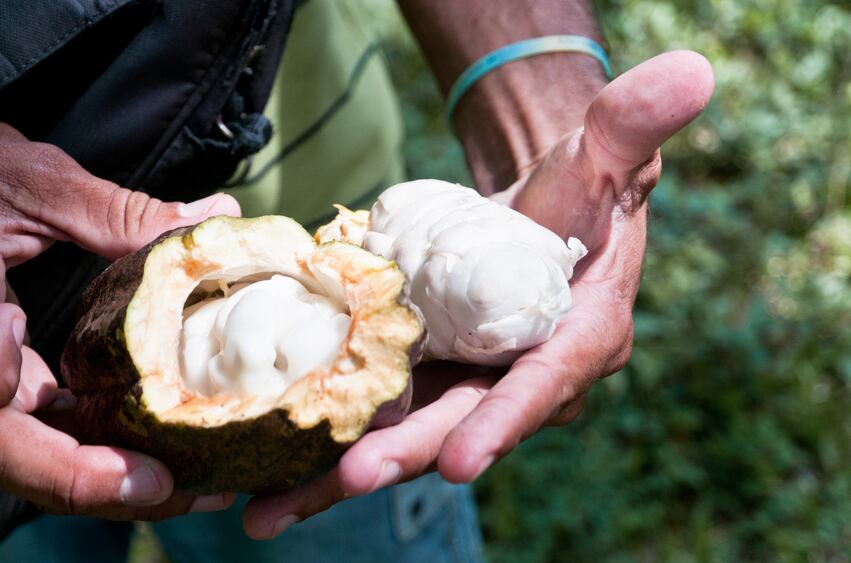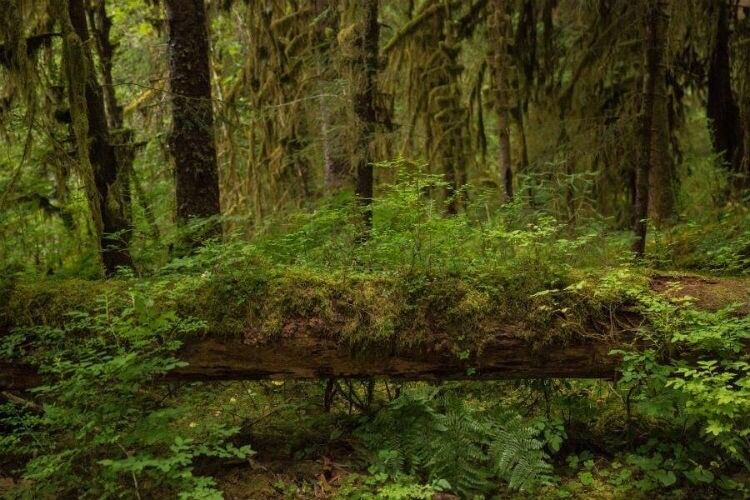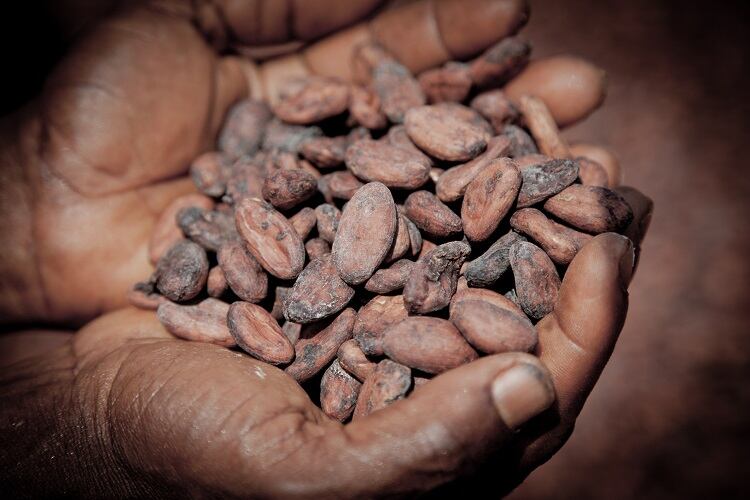Forests are being depleted as the amount of land dedicated to cocoa production grows. Between 2012 and 2016, 14.1m hectares of forest was lost in the top 30 cocoa producing countries worldwide, while 448,309 hectares of harvested cocoa area was added, a new report from Lumina Intelligence reveals. And, while World Bank forest cover data is yet to be published for 2017, the expansion of land being used to grow cocoa increased by almost a million hectares in that year alone.
The Cocoa and Forests Initiative (CFI), a public-private agreement backed by the World Cocoa Foundation, has been signed by 34 companies making up 85% of global cocoa usage. Under the CFI, these companies committed to ending cocoa-driven deforestation in the world’s largest cocoa producing countries: Ghana and Côte d’Ivoire.
But while the industry has united behind a drive to end cocoa deforestation, significant challenges remain, Oliver Nieburg, a sustainability analyst at Lunina Intelligence and author of the report, observed. “It’s not a simple topic… The situation is nuanced and complex.”
The prevalence of poverty
According to Nieburg, ‘multiple factors’ are driving deforestation in cocoa – but they all come back to one thing. Poverty.
“The income among farmers, particularly in West Africa, is so low and there are multiple reasons for that. It isn't just a matter of price. It's linked to aging tree stocks. It's linked to supporting a large family size, which in Cote d'Ivoire can be between six and seven people per household. There are unpredictable factors like weather. Farmers may struggle to access finance to be able to invest in crops and diversify their income.”
Low payments to farmers are compounded by low productivity and poor yields, which require investment to address. “The premiums are quite low and leave a lot of aging farmers struggling to invest in their farms and get their yields up to around one, 1.5 tons, per hectare. The current level is around 300 kilograms per hectare.
“That poverty scenario has been driving farmers to seek more land, to grow more cocoa on, to get more income.”
Lumina Intelligence is a data and insight provider owned by FoodNavigator publisher William Reed Business Media. It provides insight into a range of areas, including sustainability, sports nutrition and probiotics.
Rather than increasing the premiums they pay for cocoa, chocolate makers have typically responded to this situation with a focus on farmer education. These measures are designed to create a virtuous cycle by boosting yields, farmer resilience and security of supply through the promotion of good agricultural practice and crop diversification.
However, Nieburg told FoodNavigator, there are some innate difficulties with this approach that industry giants are only now ‘starting to change’ their strategies to address.
“There has been a top-down approach from companies of training farmers in good agricultural practices in the hope that they'll invest in their farms. But there are lots of financial barriers to be able to do that in the first place. Partly due to distrust, partly due to not being financially able to do what the companies were hoping that they would, that investment on the farm hasn’t happened.
“Farmers have not been able to diversify their income because it is a fiscal matter. If you chop down trees to replant, if you trunk chop cocoa to replant with other crops, it will take some time to yield results. Maybe five, 10 years down the line, you may diversify your income to a level that gives you more security in those fluctuating commodity markets.”
The ‘much bigger problem’ of the indirect supply chain
Farmers that have access to company sustainability programmes are those that directly supply cocoa, often through their membership of cooperative organisations. According to Nieburg, these direct suppliers likely account for less than 50% of all farmers. The rest are indirect suppliers, smallholder farmers that sell low volumes of cocoa to middlemen.

Nieburg suggested that this indirect supply chain represents a ‘much bigger problem’ when it comes to deforestation issues – and one that is ‘quite difficult to solve’.
“There are a lot of farmers, particularly in Cote d'Ivoire, in this disorganized supply chain who are operating in previously illegal areas in classified forest.”
These smallholders often grow cocoa under canopy cover, making it difficult to detect deforestation using satellite monitoring.
Some measures have been taken to try and stem the rise of deforestation in the disorganised supply chain. In Côte d’Ivoire, for instance, Le Conseil du Cafe-Cacao (CCC) and government have agreed to a ‘final goal of achieving full traceability, from planting to the first point of purchase at a national level’.
However, Nieburg is sceptical that this will prove effective on the ground given the complex and opaque nature of the supply chain. Cocoa will often pass from smallholder farmers in remote areas, to ‘people on motorbikes’ who collect the cocoa and sell it on to a larger middleman. The commodity will then be passed to large multinational cocoa companies, who do not have traceability for that volume of cocoa. From these ingredient suppliers it will then make its way into the supply chains of the large global chocolate companies.
“Companies have traceability for the direct supply chain, where they can trace it to supplier – usually a cooperative that is part of a sustainability programme. They know where it comes from. But then there is the cocoa that they purchase which doesn’t have traceability in the indirect supply chain.
“Unbeknownst to them, they have chocolate that contains cocoa, which may have come from the deforested area.”
Olam Cocoa confirmed efforts to tackle deforestation are initially focused on its direct supply but stressed that this accounts for the majority of the cocoa it purchases. "Olam Cocoa’s commitment to achieve a net increase in tree carbon stock and a 30% increase in natural capital costs is focused on our direct source supply chain. We source two thirds of our cocoa from direct sources, so we are focusing our sustainability efforts on the majority of our cocoa supply chain first and foremost," a spokesperson told this publication. The company stressed it also supports 'wider industry efforts to tackle deforestation and restore forests' as a founding member of the CFI.
A spokesperson for Nestlé, which is also signed up to the CFI, insisted that it expects to stamp out deforestation in cocoa supply for its confectionery brands by 2025, with the expectation that 'all suppliers' to the group's confectionery business will be certified or verified deforestation-free.
"Within our Nestlé Cocoa Plan, we are working with suppliers and farmer cooperatives to transform our cocoa supply so that it: improves livelihoods, contributes to eliminating child labour and contributes to the elimination of deforestation... By expanding to 100% Nestlé Cocoa Plan in confectionery by 2025, all our cocoa sourced will need to comply with certified or verified no deforestation."
Nestlé's confectionery business accounts for around 75% of all cocoa purchased by the group, the spokesperson added.
Mars also stressed that its ambitions cover direct and indirect suppliers. "Our approach to protecting forests and to deforestation is applicable to our entire supply chain... We work with all of our cocoa suppliers to drive traceability with a view to being 100% traceable from farmer organisation or cooperative by 2025," a spokesperson explained.
As of 2018, the confectionery giant could trace 95% of its cocoa to country of origin, 40% to a farmer group and 23% to a farm boundary.
‘Take joint responsibility for indirect supply chain’
To tackle deforestation in the indirect supply chain, these farmers require comparable support to that given through company sustainability programmes. In the Lumina report, Nieburg proposes the chocolate industry should take ‘joint responsibility’ to address issues in the indirect supply chain.
On the one hand, he suggests companies could increase the volumes of cocoa purchased through the direct supply chain. On the other, he believes there is an opportunity to ‘collectively address a landscape rather than looking at the topic individually’.
The CFI is a strong example of pan-industry collaboration and, Mars added, it is currently 'exploring potential landscape approaches' in certain countries with industry players. However, collective action nevertheless requires a further mind-set shift, Nieburg believes. Companies would have to be willing to open up their data, sharing information on things like farm yields and transaction information, he suggested.
Nieburg is a proponent of the establishment of ‘regional service centres’ that could oversee the indirect supply chain and advance sustainability initiatives in line with the CFI measures. This would require financing from government, industry and even retailers. And it would be dependent on the uptake of digital technologies, such as blockchain, to support traceability.
When it comes to company commitments targeting zero deforestation, Nieburg said a lack of traceability means that companies simply can’t assess whether indirect cocoa is deforestation-free or not.
“Some companies are committed to scale up that direct supply chain to 100% and that no deforestation commitment is basically aligned with scaling up direct supply. Others… you just wouldn't know [if deforestation is occurring in] that indirect potion supply chain,” Nieburg explained.
As companies focus on building their direct supply, there is also a danger that cocoa from the indirect supply chain could find new buyers in emerging markets ‘where a sustainability plan isn’t in place’. This would mean that deforestation in the unorganised cocoa sector could continue unchecked as smallholders open new areas of forest to increase yields, the sustainability expert warned.
Reforestation commitments still ‘dwarfed’ by deforestation focus

To develop a sustainable cocoa supply chain, Nieburg believes reforestation efforts also need to be higher up the agenda.
There is currently a ‘huge gap’ between the area of forest that has been lost to cocoa production and reforestation plans. Nieburg would like to see greater energy and discourse around efforts to reforest degraded land.
“A lot of the efforts are concentrated on creating agroforestry, which I think is good. Those commitments to agroforestry, while even they don't quite go far enough, they completely dwarf the commitments to reforestation to replace all this forest that's been cleared. There's very in the way of commitments from industry and governments to reforest.
“As we're at a climate tipping point, it's a worry because while agroforestry is good, it's not akin in carbon sequestration and in biodiversity to protected forest. Without making up for deforestation with reforestation elsewhere, you're contributing to emissions at a point where the world is sort of at a crossroads.”
While Nieburg stressed the monumental significance of reforestation on climate change, he conceded that the question of where can be reforested after populations move into previously protected forests is ‘complex’.
Nevertheless, an approach that focuses on regeneration ‘is starting to come through’, Nieburg believes.
Mondelez is ‘piloting’ a programme where farmers receive payments for environmental services and agroforestry. Farmers are paid for planting shade trees or reforestation efforts. 'It incentivises good environmental practices' and enables farmers to invest in their farms, Nieburg suggested.
A spokesperson for the Cadbury-to-Oreo maker explained that it is combating deforestation through its lifecycle assessment, which 'helps to shape our priorities and goals' and looks at the contribution to emissions from land-use change for the company's direct cocoa, palm oil and soy purchases. "We strategically continue to focus where we can make the biggest impact... Insights from our lifecycle assessment indicate that deforestation within our supply chain represents the largest single contributor to our end-to-end carbon footprint. Deforestation is a risk to the productivity of our raw material supply chains because of its contribution to global climate change as well as its impact on local weather patterns and ecosystem services in affected areas."
Elsewhere, Barry Callebaut has built a ‘forest positive’ approach into its deforestation strategy. The company has said that by 2025 it will be ‘carbon and forest positive’, looking at both the carbon footprint of its supply chain and hectares of forest regenerated. And, as noted, Olam set a target for a net increase in tree carbon stock in its cocoa supply chain by 2030.
Meanwhile, earlier this week Nestlé said it will plant ‘at least’ three million trees in key sourcing locations throughout Latin America by 2021. This commitment, the company said, is the ‘initial phase’ of its broader reforestation initiative and its commitment to hit net zero emissions by 2050.
"Planting trees not only captures carbon but also helps rebuild forests and communities, protect threatened and endangered biodiversity, promote soil nutrients, and conserve water – all of which help increase the resilience of farmers," said Magdi Batato, EVP and head of operations at Nestlé. "Reforestation also complements our commitment to halt deforestation in our supply chains. Tackling climate change requires multiple solutions."
For Nieburg, while these steps are ‘encouraging’, the devil is in the detail. “Reforestation’s success will depend on the quality of planting materials, and the carbon storage potential of the replanted tree species.
“The important detail will be the calculations. Are the indirect emissions (scopes 2 and 3) in a company’s supply chain included? And if carbon storage through reforestation is to outweigh net emissions in a company supply chain, what is the carbon storage calculation companies are using per tree?”



